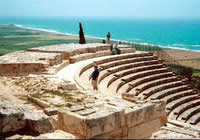|
|
| |
| |
| |
|
| |
 |
| |
|
| uses Google technology and indexes
only and selectively internet - libraries
having books with free public access |
|
 |
|
|
 |
|
| |
|
| |
Previous | |
Next |
|
 |
CLAUDE DELAVAL COBHAM
Exerpta Cypria
page 466 View PDF version of this page FRANKLAND.
Captain Charles Colvillo Frankland, R.N., sailing from jEgina in H.JI.S. " Raleigh," Capt. Dalling* readied Cyprus August 9, 1827. His Travels to und frovi Constantinople was published in 2 vols. 8vo,, London, 1880. Sec vol. i. pp. 315—824.
August 9. In the morning we made C. Blanco in the Island of Cyprus. All the day running with a fine breeze along shore towards Larneca. We passed C. Gatto and C. Salines, and made tho point Chitti about sunset. At about nine, sounded off C. Chitti in five fathoms. We anchored in the roads of Larneca, about II P.M. in eight fathoms. (N.B. (-Jive C. Chitti a wide berth.)
August 10. In the morning the British Consul came on board...I went on shore in the evening with Dalling. The Marina of Larneca is a wretched place consisting of a long vow of mud-built houses with Hat roofs : it has a bazaar and a castle. The palm trees whieh are thinly scattered about the back of the town give it a very Egyptian appearance, and I am told make it very much resemble Alexandria. The Consul sent his carriage for us, to convey us to his residence at Larneca, about three-quarters of a mile from the Marina. It was an open kind of Calèche drawn by one horse, just such a one as Gil Bias and his friend Scipion went down in to Andalusia, to take possession of his quinta at Leria.
On onr way out saw a few Cyprians. God only knows how this island ever attained its celebrity for beauty ; for to judge of it freni the specimens we saw one would have said it was the last place which Venus would have chosen in which to fix her favourite residence. I am told, however, that in the neighbourhood of Paphos (whose temple still exists) il y ale phis bean sang possible. The male part of the population is handsome and robust: and perhaps the laughing and wanton goddess had an eye to this circumstance. The Consular residence is spacious and cool. The old gentleman received us with much politeness and urbanity, offering ns beds, &c. He has several daughters, but 1 in vain looked for a Haidee among them...Pipes and coffee employed the evening, and at about nightfall we returned to our bark.
August 11. All the morning at the Marina with Dalling. At noon we drove onta la Gil Bias to Larneca. We dined with the Consul, and saw several of the European Consuls— tutti illustrissimi Signori. I observed at dinner that the fair Consulesses had tinged their finger-nails with henna, à la Turque. It is curious to observe how much the Greeks in their humiliation and slavery imitate their masters in their fashions nnd absurdities. I should have remarked that our Consul is by birth an Ionian, and that he had married a Greek Cypriote ; his daughters therefore are Greek in costume, language and ideas.
I observed that in most of the houses at Larneca the ceiling of the large rooms is supported by a Gothic or rather Saracenic arch. The beams likewise rest upon such wooden projecting supports or buttresses as we see in old churches in England under the woodwork of the roof. Many of the houses have a kind of façade extending half the height of the house, of stone, and of the same order of Saracenic architecture. I think that some antiquarians trace the origin of this style of building in England back to the days of Crusaders, who are said to have found it existing in Cyprus and Palestine, and to have imported it into Europe on their return. 1 observed likewise several columns with such capitals and pedestals as we see in churches of the Gothic style.
EXCERPTA CYPRIA.
View PDF version of this page
|
 |
| |
Previous |
First |
Next |
|
|
|